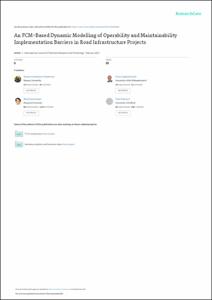Please use this identifier to cite or link to this item:
http://localhost/handle/Hannan/4725
| Title: | An FCM-Based Dynamic Modelling of Operability and Maintainability Implementation Barriers in Road Infrastructure Projects |
| Authors: | Nazanin Kordestani Ghaleenoei;Ehsan Saghatforoush;Taha Mansouri;Ahad Zareravasan |
| subject: | Fuzzy cognitive mapping (FCM) · Operability and maintainability (OM) · Operability and maintainability barriers · Road infrastructure |
| Year: | 2020 |
| Abstract: | Building a new road infrastructure in the country leads to economic and industrial growth. A massive amount of money is paid by governments to build them; however, they fail due to many reasons related to operability and maintainability (O&M) issues. They are not also completed within the expected budget, time, and quality; so they are not justifiable. As these factors have a strong impact on projects, to reduce the final cost and other mentioned problems, it is necessary to identify the existing O&M barriers, their interrelationships, and their effects on the three mentioned factors. An in-depth literature review is conducted to identify the barriers. The fuzzy cognitive mapping (FCM) technique is used to model O&M barriers using real case data analyses. The findings reveal that managerial factors have more significanct impacts on the project’s success compared to other factors such as organizational, human resource, technology, and project management. Therefore, management methods are very important in developing integration in the project. Identifying, classifying, and determining the effects of barriers to entry of O&M contractors on the cost, time, and quality of road infrastructure projects show the signifcance of conducting this research, which is necessary to deal with the existing barriers. All these ultimately increase quality and reduce time and cost in road infrastructure projects. |
| URI: | http://localhost/handle/Hannan/4725 |
| Appears in Collections: | مدیریت پروژه و ساخت |
Files in This Item:
| File | Description | Size | Format | |
|---|---|---|---|---|
| 72.pdf | 1.16 MB | Adobe PDF |  Preview File |
| Title: | An FCM-Based Dynamic Modelling of Operability and Maintainability Implementation Barriers in Road Infrastructure Projects |
| Authors: | Nazanin Kordestani Ghaleenoei;Ehsan Saghatforoush;Taha Mansouri;Ahad Zareravasan |
| subject: | Fuzzy cognitive mapping (FCM) · Operability and maintainability (OM) · Operability and maintainability barriers · Road infrastructure |
| Year: | 2020 |
| Abstract: | Building a new road infrastructure in the country leads to economic and industrial growth. A massive amount of money is paid by governments to build them; however, they fail due to many reasons related to operability and maintainability (O&M) issues. They are not also completed within the expected budget, time, and quality; so they are not justifiable. As these factors have a strong impact on projects, to reduce the final cost and other mentioned problems, it is necessary to identify the existing O&M barriers, their interrelationships, and their effects on the three mentioned factors. An in-depth literature review is conducted to identify the barriers. The fuzzy cognitive mapping (FCM) technique is used to model O&M barriers using real case data analyses. The findings reveal that managerial factors have more significanct impacts on the project’s success compared to other factors such as organizational, human resource, technology, and project management. Therefore, management methods are very important in developing integration in the project. Identifying, classifying, and determining the effects of barriers to entry of O&M contractors on the cost, time, and quality of road infrastructure projects show the signifcance of conducting this research, which is necessary to deal with the existing barriers. All these ultimately increase quality and reduce time and cost in road infrastructure projects. |
| URI: | http://localhost/handle/Hannan/4725 |
| Appears in Collections: | مدیریت پروژه و ساخت |
Files in This Item:
| File | Description | Size | Format | |
|---|---|---|---|---|
| 72.pdf | 1.16 MB | Adobe PDF |  Preview File |
| Title: | An FCM-Based Dynamic Modelling of Operability and Maintainability Implementation Barriers in Road Infrastructure Projects |
| Authors: | Nazanin Kordestani Ghaleenoei;Ehsan Saghatforoush;Taha Mansouri;Ahad Zareravasan |
| subject: | Fuzzy cognitive mapping (FCM) · Operability and maintainability (OM) · Operability and maintainability barriers · Road infrastructure |
| Year: | 2020 |
| Abstract: | Building a new road infrastructure in the country leads to economic and industrial growth. A massive amount of money is paid by governments to build them; however, they fail due to many reasons related to operability and maintainability (O&M) issues. They are not also completed within the expected budget, time, and quality; so they are not justifiable. As these factors have a strong impact on projects, to reduce the final cost and other mentioned problems, it is necessary to identify the existing O&M barriers, their interrelationships, and their effects on the three mentioned factors. An in-depth literature review is conducted to identify the barriers. The fuzzy cognitive mapping (FCM) technique is used to model O&M barriers using real case data analyses. The findings reveal that managerial factors have more significanct impacts on the project’s success compared to other factors such as organizational, human resource, technology, and project management. Therefore, management methods are very important in developing integration in the project. Identifying, classifying, and determining the effects of barriers to entry of O&M contractors on the cost, time, and quality of road infrastructure projects show the signifcance of conducting this research, which is necessary to deal with the existing barriers. All these ultimately increase quality and reduce time and cost in road infrastructure projects. |
| URI: | http://localhost/handle/Hannan/4725 |
| Appears in Collections: | مدیریت پروژه و ساخت |
Files in This Item:
| File | Description | Size | Format | |
|---|---|---|---|---|
| 72.pdf | 1.16 MB | Adobe PDF |  Preview File |
